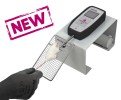Authors
Y Liang, D Zhao, R Wang et al
Lab
The First Affiliated Hospital of China Medical University, Liaoning, China;
Journal
Thyroid
Abstract
Background In humans, Resistance to Thyroid Hormone (RTH) caused by mutations in the thyroid hormone receptor alpha (THRA) gene, RTHalpha, manifests as tissue-specific hypothyroidism and circulating thyroid hormone levels that exhibits hypothyroid-like clinical features. Before the identification of patients with RTHalpha, several Thralpha1 knock-in mouse models were generated to clarify the function of TRalpha1. However, the phenotypes of these mice were not consistent with the clinical presentation of RTHalpha in humans. For the present study we generated a RTHalpha mouse model that carries the Thra1 E403X mutation found in human RTHalpha patients. Here we report the gross phenotypes of this mouse RTH_ model. Methods Traditional homologous recombination gene targeting techniques were used to introduce a mutation (Thralpha1 E403X) in the mouse Thra gene. The phenotypes of the resulting mice were studied and compared to clinical features seen for RTH_ with THRAE403X. Results Thralpha1E403X/E403X homozygous mice exhibited severe neurological phenotypes, such as spasticity and motor ataxia, which were similar to those observed in endemic cretinism. Thralpha1E403X/+ heterozygous mice reproduced most clinical manifestations of the patient with RTHalpha, such as a normal survival rate and male fertility, as well as delayed postnatal growth and development, neurological and motor coordination deficits, and anemia. The mice had typical thyroid function with a modest increase in serum T3 levels, a low of T4/T3 ratio, and low rT3 levels. Conclusions The Thralpha1E403X/+ mice faithfully recapitulate clinical features of human RTHalpha, and thus can provide a useful tool to dissect the role of TRalpha1 in development and to determine the pathological mechanisms of RTHalpha.
BIOSEB Instruments Used:
Grip strength test (BIO-GS3)

 Pain - Thermal Allodynia / Hyperalgesia
Pain - Thermal Allodynia / Hyperalgesia Pain - Spontaneous Pain - Postural Deficit
Pain - Spontaneous Pain - Postural Deficit Pain - Mechanical Allodynia / Hyperalgesia
Pain - Mechanical Allodynia / Hyperalgesia Learning/Memory - Attention - Addiction
Learning/Memory - Attention - Addiction Physiology & Respiratory Research
Physiology & Respiratory Research
 Pain
Pain Metabolism
Metabolism Motor control
Motor control Neurodegeneration
Neurodegeneration Cross-disciplinary subjects
Cross-disciplinary subjects Muscular system
Muscular system General activity
General activity Mood Disorders
Mood Disorders Other disorders
Other disorders Joints
Joints Central Nervous System (CNS)
Central Nervous System (CNS) Sensory system
Sensory system
